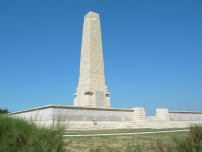| First Name: | Arthur Henry | Last Name: | MUIR | |
|---|---|---|---|---|
| Date of Death: | 25/04/1915 | Lived/Born In: | Camberwell | |
| Rank: | Sergeant | Unit: | Lancashire Fusiliers1 | |
| Memorial Site: | Helles Memorial, Gallipoli | |||
Current Information:Born-Chelsea
Gallipoli 1915 On 25 April, 1915, British, Australian and New Zealand forces landed on the Gallipoli peninsula. The plan was that these forces would soon defeat a demoralised Turkish army, knock Turkey out of the war, open up the Mediterranean to the Russian navy and threaten Austro-Hungary from the south.None of these things were achieved despite nine months of hard fighting in terrible conditions. It was a heroic failure. The 29th Division and the Royal Naval Division landed at five separate beaches around Cape Helles. Some were not defended, others were fiercely contested. Some ground was gained but within days the familiar pattern of trench warfare had set in. A similar pattern emerged further north where the ANZACS landed. The Turkish soldiers were much tougher fighters than had been given credit for and they were of course fighting an invasion of their homeland. The terrain, a series of steep rocky ridges and deep gullies made the fighting much more difficult and during the hot summer of 1915, the flies arrived in biblical proportions. Another seven British divisions were sent to Gallipoli during the summer but little or no progress was made. In the end, a new Commander was appointed and plans to evacuate the entire force were drawn up. By January 1916, all British, Australian and New Zealand forces had left Gallipoli, leaving only behind the dead, over 56,000 of them. The landing of the1st Lancashire Fusiliers battalion of 86 Brigade, 29th Division at “W” Beach, Cape Helles, on 25th April, 1915, has been remembered ever since for the heroism of those who took part. Indeed, it was seen fit to award the Victoria Cross to six members of the battalion for their individual actions on that morning. Approaching the beach the thirty six cutters which were carrying three of their Companies were not fired on until they actually hit the beach. Then all hell broke loose with Turkish machine gun and rifle fire sweeping the men as they tried to get ashore. To add to their woes they found that the wire entanglements at the waters edge had not been destroyed. 1st Lancashire Fusiliers hurled themselves at this barrier and tore their way through it whilst the Turkish fire went on unabated. Enough of them got through and engaged the Turkish forces and fought their way further inland. The fourth Company landed a little to the north and were able to avoid the worst of the enemy fire and attack them in the flank. A line was established and the cliff behind the beach was scaled as Turkish resistance lessened. But even then their troubles were not over. The survivors of “A” Company made it to the top of the cliff arriving at the same time as a large Royal Naval shell which blew many of them back down again. One hundred and sixty five men from 1st Lancashire Fusiliers were killed at “W” Beach, including over thirty from London. One of these was Arthur Muir. |
||||
| « Back to Search Results | ||||
| If you think any of the information shown here is incorrect, Click Here to submit your amends and comments | ||||




